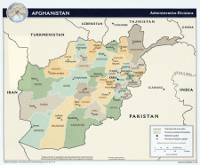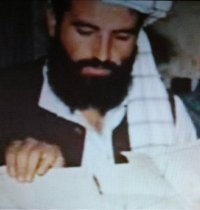Afghan and Coalition forces killed more than 20 Haqqani Network fighters and detained several more during a raid on a district known to harbor al Qaeda and other foreign fighters in eastern Afghanistan.
The Haqqani Network fighters were killed “during an on-going clearing operation aimed at disrupting the Haqqani Network’s freedom of movement” in the district of Zadran in Paktia province, the International Security Assistance Force reported in a press release.
The Haqqani Network fighters were killed as Afghan commandos backed by US forces were engaged by “dozens of insurgents occupied entrenched fighting positions throughout the mountainous area” with “machine guns, rocket-propelled grenades and automatic weapons.” The combined force called in airstrikes on the Haqqani Network positions, killing more than 20 fighters.
ISAF described the district of Zadran as a “known Haqqani Network safe haven” which is “used to stage attacks into Kabul and the Khost-Gardez pass.”
Coalition and Afghan forces have been conducting special operations raids targeting the Haqqani Network and al Qaeda operatives in Paktia on a near-daily basis. Over the past several days the combined force captured a Haqqani Network sub-commander who facilitates the movement of weapons into Gardez district and a commander who led two cells in the district of Zurmat. Dozens more fighters have been killed or captured.
In mid-June, Afghan and Coalition forces killed “a large number” of Haqqani Network and foreign fighters during a major clash in the Jani Khel district in Paktia, and another 38 as they crossed the provincial border into Musa Khel in Khost. “Arabs, Uzbeks, Turks, and Chechens” were among those killed in the fight in Jani Khel in Paktia.
Al Qaeda maintains a presence in Paktia province, according to an investigation by The Long War Journal. US military press releases document the presence of al Qaeda and Islamic Jihad Union cells, as well as Hizb-i-Islami Gulbuddin (HIG) cells, in the districts of Jani Khel, Zadran, and Zurmat; or three of Paktia’s 11 districts.
The Long War Journal has been able to detect the presence of al Qaeda and affiliated groups such as the Islamic Jihad Union in 46 different districts in 16 of Afghanistan’s 34 provinces. These cells are not limited to areas in the south and east; cells have been detected in the provinces of Farah and Herat in the west, Kunduz in the north, and Kapisa in central Afghanistan.
Al Qaeda operates in conjunction with the Taliban, the Haqqani Network, and the Hizb-i-Islami Guldbuddin network throughout Afghanistan. Al Qaeda operatives often serve as embedded military trainers for Taliban field units and impart tactics and bomb-making skills to these forces. Al Qaeda often supports the Taliban by funding operations and providing weapons and other aid, according to classified military memos released by Wikileaks.
Background on the Haqqani Network
The Haqqani Network has extensive links with al Qaeda and the Taliban, and its relationship with Pakistan’s Inter-Services Intelligence agency has allowed the network to survive and thrive in its fortress stronghold of North Waziristan. The Haqqanis control large swaths of the tribal area and run a parallel administration with courts, recruiting centers, tax offices, and security forces. They have established multiple training camps and safe houses used by al Qaeda leaders and operatives, as well as by Taliban foot soldiers preparing to fight in Afghanistan.
The Haqqani Network has been implicated in some of the biggest terror attacks in the Afghan capital city of Kabul, including the January 2008 suicide assault on the Serena hotel, the February 2009 assault on Afghan ministries, and the July 2008 and October 2009 suicide attacks against the Indian embassy. American intelligence agencies confronted the Pakistani government with evidence, including communications intercepts, which proved the ISI’s direct involvement in the 2008 Indian embassy bombing. [See LWJ report “Pakistan’s Jihad” and Threat Matrix report “Pakistan backs Afghan Taliban” for additional information on the ISI’s complicity in attacks in Afghanistan and the region.]
The Haqqani Network is led by Jalaluddin Haqqani and his son, Sirajuddin. Jalaluddin is thought to be ill and is considered the patriarch of the network. Siraj runs the daily operations and is the group’s military commander.
Siraj is one of the most wanted Taliban and al Qaeda leaders in the Afghan-Pakistan region. The US military has described Siraj as the primary threat to security in eastern Afghanistan. He is the mastermind of the most deadly attacks inside Afghanistan, including suicide assaults in Kabul, and he is the senior military commander in eastern Afghanistan. He is the leader of the Taliban’s Miramshah Regional Military Shura, one of the Afghan Taliban’s four regional commands [see LWJ report, “The Afghan Taliban’s top leaders“].
Siraj is considered dangerous not only for his ties with the Afghan Taliban, but also because of his connections with al Qaeda’s central leadership, which extend all the way to Osama bin Laden. Siraj is a member of al Qaeda’s Shura Majlis, or top council, US intelligence sources told The Long War Journal. In a tape released in April 2010, Siraj admitted that cooperation between the Taliban and al Qaeda “is at the highest limits.” On March 25, 2009, the US Department of State put out a $5 million bounty for information leading to the capture of Siraj.
The US Treasury recently added Nasiruddin Haqqani, Siraj’s brother, to the list of specially designated global terrorists. Nasiruddin is a key financier and emissary for the Haqqani Network. According to the Treasury, Nasiruddin has traveled to Saudi Arabia and the United Arab Emirates between 2004-2009 to carry out fundraising for the Haqqani Network, al Qaeda, and the Taliban.
Despite Siraj’s ties with al Qaeda, and the Haqqani Network’s use of suicide attacks, some top US military commanders have stated that Jalaluddin Haqqani, his father, and Gulbuddin Hekmatyar, another supporter of al Qaeda, are “absolutely salvageable” and ripe for negotiations.
“The HIG already have members in Karzai’s government, and it could evolve into a political party, even though Hekmatyar may be providing al Qaeda leaders refuge in Kunar,” Major General Michael Flynn, the top military intelligence official in Afghanistan, told The Atlantic in April 2010. “Hekmatyar has reconcilable ambitions. As for the Haqqani network, I can tell you they are tired of fighting, but are not about to give up. They have lucrative business interests to protect: the road traffic from the Afghanistan-Pakistan border to Central Asia.”
Sir Graeme Lamb, a senior adviser to General McChrystal, echoed Flynn’s view on Hekmatyar and Haqqani, and discounted the groups’ close ties to al Qaeda.
“Haqqani and Hekmatyar are pragmatists tied to the probability of outcomes,” Lamb also told The Atlantic. “With all the talk of Islamic ideology, this is the land of the deal.”
A Haqqani Network leader known as Zakim Shah serves as the shadow governor of Khost province. Khost, Paktika, and Paktia provinces are the main strongholds of the Haqqani Network in eastern Afghanistan. The Haqqani Network also has a presence in the provinces of Logar, Wardak, Nangarhar, Ghazni, Zabul, and Kabul.
The Haqqani forces in Paktika province are commanded by Mullah Sangeen Zadran, a senior lieutenant to Sirajuddin Haqqani. A US military intelligence official told The Long War Journal that Sangeen also commands forces outside of Paktika and that he has become one of the most dangerous operational commanders in eastern Afghanistan.
Last summer, Sangeen took credit for the kidnapping of a US soldier who apparently stepped away from his post at a combat outpost in Paktika on June 30, 2009. US forces in eastern Afghanistan launched a massive manhunt for the soldier, but failed to find him. The soldier is believed to be held across the border in Pakistan’s Taliban-controlled tribal agency of North Waziristan.
US and Afghan forces hit the Haqqani Network hard in the summer of 2009 during a series of raids in Khost, Paktika, Paktia, Logar, and Zabul. Major battles were fought in mountainous regions as the joint forces assaulted heavily defended Haqqani Network “fortresses.” The raids failed to dislodge the Haqqani Network from the provinces.
The Haqqani Network has also been heavily targeted by the CIA in the covert air campaign in Pakistan’s tribal areas. Siraj has been the target of multiple Predator strikes. His brother, Mohammed, who served as a military commander, was killed in a February 2010 strike in North Waziristan.










1 Comment
This pattern is one of tit for tat. We need to release the hounds and implement a military strategy where our TOE do not hamstring our troops. Hopefully, Patreaus can see this and obliterate our enemy. It’s what they understand the most. I recognize my thinking may be perceived as elementary but let our men and women fight.